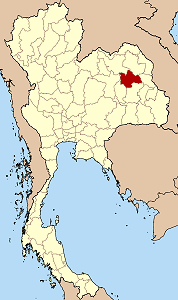Kalasin province
| Statistics | |
|---|---|
| Capital: | Kalasin |
| Area: | 6,946.7 km² Ranked 29th |
| Inhabitants: | 921,366 (2000) Ranked 21st |
| Pop. density: | 133 inh./km² Ranked 30th |
| ISO 3166-2: | TH-46 |
| Map | |

| |
Kalasin (Thai กาฬสินธุ์) is one of the provinces (changwat) of Thailand, located in the North-East of Thailand. Neighboring provinces are (from north clockwise) Sakhon Nakhon, Mukdahan, Roi Et, Maha Sarakham, Khon Kaen and Udon Thani.
Geography
Most of the province is covered by hilly landscape. In the north is the Lam Pao dam built 1963-68, storing 1,430 million m³ of water for flood prevention and agriculture. At the border to the Sakhon Nakhon province is the Phu Phan mountain range, which is preserved as a national park.
History
Archeological excavations showed that the Lawa tribe already lived in the area in prehistoric times 1600 years ago. However, the first town was founded in 1793. The province was created in 1959 when it was split off from Maha Sarakham.
Symbols
| Seal of the province | The seal of the province shows a pond in front of the mountains which form the boundary of the province. The water in the pond is black, as the name Kalasin means "black water". The big clouds as well as the water symbolize the fertility of the province.
The provincial flower is Payorm or Sweet shorea (Shorea roxburghii), and the provincial tree is Sa-mae-san (Cassia garrettiana). |
Administrative divisions
The province is subdivided into 14 districts (Amphoe) and 4 minor districts (King Amphoe). The districts are further subdivided into 134 communes (tambon) and 1509 villages.
| Amphoe | King Amphoe | |
|---|---|---|
|
|
|